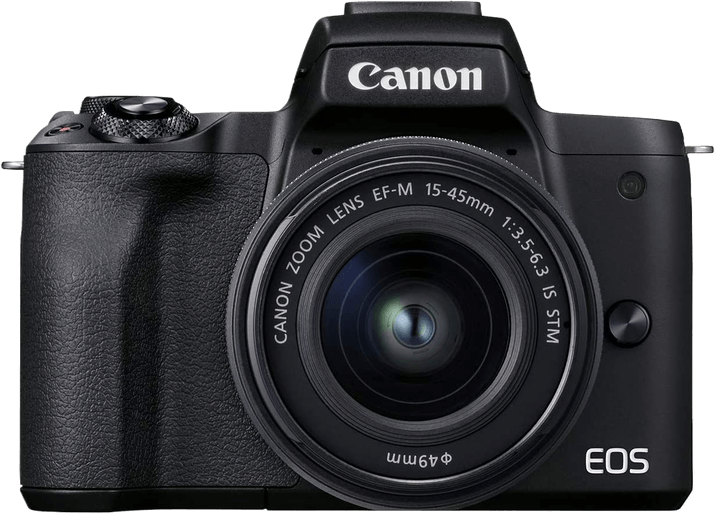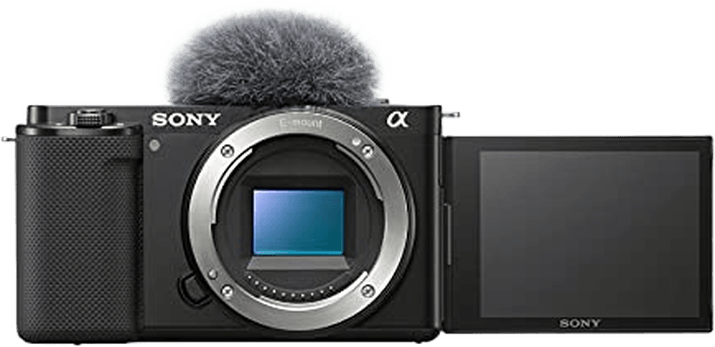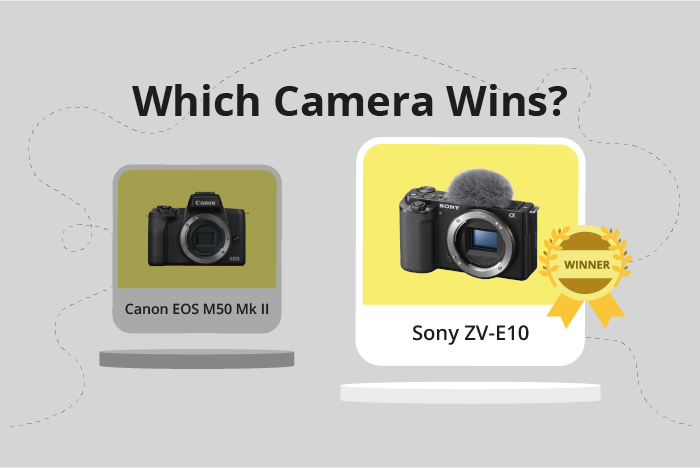Canon EOS M50 Mark II vs Sony ZV-E10 Comparison
Canon EOS M50 Mark II

Sony ZV-E10

The Sony ZV-E10 wins the comparison with a score of 65/100, while the Canon EOS M50 Mark II scores 59/100. Both cameras are mirrorless and were released in 2020 and 2021, respectively. They share common specifications such as launch price, with the Sony ZV-E10 priced at $700 and the Canon EOS M50 Mark II at $750.
The Sony ZV-E10 has a better score due to its lighter weight (343g) and smaller size (115 x 64 x 45mm), making it more portable and convenient for users. On the other hand, the Canon EOS M50 Mark II has a slightly higher launch price, which could be an advantage for those looking for a more premium product.
When comparing the two cameras, the Sony ZV-E10 is the better choice due to its higher score and more compact design. The Canon EOS M50 Mark II may still appeal to some users due to its slightly higher price, but overall, the Sony ZV-E10 is the winner in this comparison.
Canon EOS M50 Mark II vs Sony ZV-E10 Overview and Optics
The Sony ZV-E10 takes the lead in optics with a score of 69/100, while the Canon EOS M50 Mark II trails behind at 59/100. Both cameras share some common specifications, such as 24 megapixels, a CMOS sensor, an APS-C sensor size, and no image stabilization. However, the differences in their scores stem from the distinct features each camera offers.
The Sony ZV-E10 outperforms the Canon EOS M50 Mark II in several aspects. It has a faster shooting speed of 11 compared to 10, which allows for capturing moments more efficiently. Additionally, the Sony ZV-E10 has a higher DXOMARK score for the sensor at 86, compared to the Canon EOS M50 Mark II’s score of 58. This difference results in better image quality and improved low-light performance. Furthermore, the Sony ZV-E10 has a 4:3 aspect ratio, providing more flexibility in framing and composition.
On the other hand, the Canon EOS M50 Mark II has its advantages as well. It features a Digic 8 processor, which contributes to faster processing and better image quality. Moreover, the Canon EF-M lens mount offers compatibility with Canon’s range of lenses, providing more options for various shooting scenarios.
In terms of optics, the Sony ZV-E10 proves to be the stronger contender with its faster shooting speed, higher DXOMARK score, and more versatile aspect ratio. However, the Canon EOS M50 Mark II should not be disregarded, as its Digic 8 processor and lens compatibility may cater to specific user preferences. Ultimately, the choice between these two cameras depends on individual needs and priorities.
Canon EOS M50 Mark II vs Sony ZV-E10 Video Performance
The Canon EOS M50 Mark II and the Sony ZV-E10 both have a video score of 91/100, indicating that these cameras have similar video capabilities. They share common features, such as 4K max video resolution, 120fps max video frame rate, and built-in time-lapse functionality. However, there are differences between the two cameras that make each one better in certain aspects.
The Canon EOS M50 Mark II has a slight advantage in max video dimensions, offering 3840 x 2160 resolution compared to the Sony ZV-E10’s 3840 x 1920 resolution. This means that the EOS M50 Mark II provides slightly higher video quality, which can be beneficial for those who prioritize image clarity and detail.
On the other hand, the Sony ZV-E10 has its own unique strengths. Although it has a slightly lower max video dimension, this difference may not be significant enough for most users to notice. The ZV-E10 may offer other features or performance aspects that appeal to specific users, such as better autofocus or color reproduction. However, these factors are not reflected in the video score, so it is essential to consider individual needs and preferences when choosing between these cameras.
In comparing the Canon EOS M50 Mark II and the Sony ZV-E10, both cameras have impressive video capabilities with a tied score of 91/100. The EOS M50 Mark II has a slight edge in video resolution, while the ZV-E10 may offer other advantages not reflected in the score. Ultimately, the choice between these cameras depends on individual preferences and specific needs for video performance.
Canon EOS M50 Mark II vs Sony ZV-E10 Features and Benefits
The Canon EOS M50 Mark II wins in features with a score of 70/100, while the Sony ZV-E10 scores slightly lower at 68/100. Both cameras share common specifications, including a 3-inch screen, touchscreen capability, flip screen, absence of GPS, and the presence of WIFI and Bluetooth connectivity.
The Canon EOS M50 Mark II is better in terms of screen resolution, offering 1,040,000 dots compared to the Sony ZV-E10’s 920,000 dots. This higher resolution provides clearer and sharper image previews, making it easier for users to assess image quality and composition. This difference in screen resolution contributes to the Canon camera’s higher feature score.
The Sony ZV-E10, despite its lower overall score, has some advantages. For instance, the ZV-E10 and M50 Mark II share the same screen size and flip screen capability, making them equally suitable for vlogging and content creation. Both cameras also offer similar connectivity options, with WIFI and Bluetooth, allowing for easy sharing and transferring of images and videos.
Considering these points, the Canon EOS M50 Mark II edges out the Sony ZV-E10 in features, primarily due to its higher screen resolution. However, the similarities in other features mean that both cameras are still suitable for various photography and videography needs. Users should weigh the importance of screen resolution and other personal preferences when choosing between these two cameras.
Canon EOS M50 Mark II vs Sony ZV-E10 Storage and Battery
The Sony ZV-E10 wins in storage and battery with a score of 24/100, while the Canon EOS M50 Mark II scores 21/100. Both cameras have one memory card slot and do not support USB charging. They accept SD, SDHC, and SDXC memory cards, with the ZV-E10 also compatible with Memory Stick Pro Duo.
The ZV-E10 outperforms the M50 Mark II in battery life, providing 440 shots compared to the M50’s 305 shots. This longer battery life makes the ZV-E10 a more reliable option for extended shooting sessions. The M50 Mark II, however, has no significant advantages in storage and battery over the ZV-E10.
Considering these points, the Sony ZV-E10 proves to be the better choice for storage and battery life, making it more suitable for users who require longer shooting times and additional memory card compatibility.
Alternatives to the Canon EOS M50 Mark II and Sony ZV-E10
Are you still undecided about which camera is right for you? Have a look at these popular comparisons that feature the Canon EOS M50 Mark II or the Sony ZV-E10:

